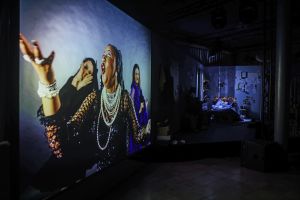
Szenenbild aus „At Your Doorstep/Vor deiner Tür“ Kammeroper in 30 Szenen UA in Johannesburg/Bielefeld 29.3.2023 Komponisten: Matthew McFarlane/Marc L. Vogler Inszenierung und Libretto: Robert Lehmeier Ausstattung: Marie-Luise Otto/Karabo Mtshali, Nthabiseng Makone
Johannesburg
Robert Lehmeier’s production of Romeo’s Passion in Johannesburg in 2018—a work based on material created in interactive workshops with young South Africans—left me with the distinct impression that I was glimpsing opera’s future, or at least its future in places outside the world’s wealthiest metropolitan centres (December 2018, pp. 1527-9). His new chamber opera (seen on April 4) has both recreated and extended that sense, not least because it now also involves state-of-the art technology that bridges distance and difference in our divided world.
Made possible by German state funding, At Your Doorstep/Vor deiner Tür is a 65-minute work designed to create intercultural exchange between audiences (especially younger people) in Germany and South Africa. But its ambition is even larger. Constellated around an online video romance between a young black man and young white woman who live on different continents, it foregrounds contemporary issues of grave importance everywhere—wars, climate catastrophe, inequality, racism, mental health—and shows how opera could play a role in addressing these.
There are just four characters. In a middle-class apartment in Bielefeld, Germany, a young woman (She) suffering from a debilitating anxiety disorder, lives with her over- protective mother; in a poor dwelling in Johannesburg, a young man (He) lives with his caring but headstrong sister. He and She meet online, fall in love, fantasize about meeting but run into serious obstacles: the mother’s Afrophobia; the sister’s reluctance to lose her brother.
Crucially, for each of its several performances the opera played simultaneously in Johannesburg’s ramolao makhene theatre and Bielefeld’s rudolf-oetker- halle. In each venue the audience watched the story unfold from the perspective of their locale. So in the Johannesburg performance, the simple home was stage centre; as He and She interacted online, a big screen on the left gave an enlarged view of the video arriving on his computer from Bielefeld. Projected onto a similar screen on the right were pages of the mainly English libretto, with translations from German and Zulu when necessary. Five of the ten-piece instrumental ensemble were on a rear platform; the other five were in Bielefeld. Of course, the German audience saw the converse of all this. Aided by click tracks, the synchronization was perfect. I was astonished by the rapid, sung interactions between what was live and what was online, and especially by those moments when live and online casts and instrumental groups combined to form an integrated operatic ensemble.
Only technological wizardry could have made this possible. Like others, I found myself believing that the online video was actually live-streaming from the other country, an impression reinforced by scripted moments when the video link appeared to break down. In reality, nothing was being streamed live: for this sort of operatic use, the technology is not yet fully adequate. So in each venue only the local domestic scene was live: the incoming video stream had been filmed in advance in the other theatre. But the illusion became even more believable when the performances in Johannesburg and Bielefeld ended simultaneously, and a video link made possible a real-time online discussion (with translator) between the separated audiences and performers.
In keeping with the librettist-director Lehmeier’s bridging and integrating intentions, everything in the work’s creation and performance was shared between the two places.
Under his guidance, the libretto was crafted in conjunction with young people who attended libretto workshops in Bielefeld and Johannesburg. And the music was co-composed—by Marc L. Vogler there, by Matthew MacFarlane here, each contributing music with idiomatic relevance to his own locale, but ultimately combining in a score marked by current modernist styles, contemporary arioso, African idioms, pop, electronic dance music, allusions to music theatre, and many good tunes.
The cast, all with international careers, sang marvelously. Because so much of the opera belongs to the young lovers, July Zuma (He) and Mayan Goldenfeld (She) made a particularly strong impression, as focused vocally as they were compelling dramatically.
Nohad Becker (Mother) and Nokuthula Magubane (Sister) gave superb support. Judging from the discussion, the audiences in both places found the experience captivating—even though for most of the Johannesburg audience, mainly young and overwhelmingly black, this was their first encounter with live opera. As was true of Romeo’s Passion, this work could tour widely. And it should: for anyone interested in what a viable future for opera could look like, this piece offers an experience at once unforgettable, instructive and hugely enjoyable. Christopher Ballantine